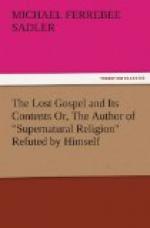Now, who is this Man Whose figure stands thus prominent above His fellows?
We believe Him to be our Redeemer; but before He redeemed, He laid down the necessity of Redemption by making known to men the true nature of sin and righteousness, and the most just and inevitable Judgment of God. He revealed to us that there is One above us Who is to the whole race, and to every individual of the race, what our consciences are to ourselves—a Judge pronouncing a perfect judgment, because He perfectly knows the character of each man, perfectly observes and remembers his conduct, and, moreover, will mete out to each one a just and perfect retribution.
But still, how are we to know that He has authority to reveal to us such a thing as that God will judge the race and each member of it by a just judgment? Natural laws reveal to us no such judgment. Nature teaches us that if we transgress certain natural laws we shall be punished. But it teaches no certain judgement either in this life or in any future life which will overtake the transgression of moral laws. A man may defraud, oppress, and seduce, and yet live a prosperous life, and die a quiet, painless death.
How, then, are we to know that Jesus of Nazareth had authority to reveal that God will set all this right in a future state, and that He Himself will be the direct Agent in bringing the rectification about? How are we to know that what He says is true respecting a matter of such deep concern to ourselves, and yet so utterly unknown to mere physical nature, and so out of the reach of its powers? What proof have we of His Revelation, or that it is a Revelation? The answer is, that as what He revealed is above mere physical nature, so He attested it by the exhibition of power above physical nature—the exhibition of the direct power of God. He used miracles for this purpose; more particularly He staked the truth of His whole message on the miracle of His own Resurrection. [155:1] The Resurrection was to be the assurance of the perfection of both His Redemption and His Judgment.
Now, against all this it is persistently alleged that even if He had the power He could not have performed miracles, because miracles are violations of law, and the Lawgiver cannot violate even mere physical laws; but this specious fallacy is refuted by the simple assertion that He introduced a new power or force to counteract or modify others, which counteraction or modification of forces is no more than what is taking place in every part of the world at every moment.
Before proceeding further we will illustrate the foregoing by testing some assertions of the author of “Supernatural Religion.”
“Man,” he asserts, “is as much under the influence of gravitation as a stone is” (vol. i. p. 40). Well, a marble statue is a stone. Can a marble statue, after it is thrown down, rise up again of itself, and stand upon its feet?
Again—




